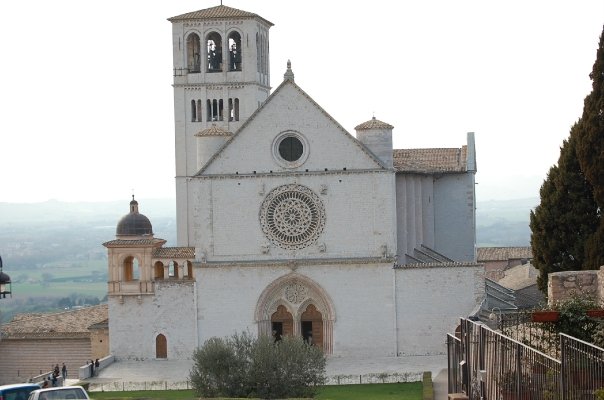
Walking through the early spring air, pierced with morning sunrays and weighted by the touch of dew, we set off on our one-day pilgrimage to Assisi. The morning train from Florence to Assisi took us away from the noise and clutter of rising markets, the rushing of people and the overall frenzy so typical of the city of Florence. This trip was not merely a physical movement, but also a spiritual attempt to restore tranquility and to remind oneself of the connection with nature.
Upon arrival in Assisi, we took a moment to admire the view of the place which we were to “conquer”: standing on the bottom of the Hill of Paradise, formerly known as the Hill of Hell, we looked at the magnificent Basilica of St. Francis. Taking a detour by walking through meadows rather than passing through the town’s streets on our way to the Basilica postponed a “confrontation” with the town. Passages from Dante’s Divine Comedy were read in Italian and English during the short breaks.
The Basilica of St. Francis was built to honour the local saint, Francis of Assisi, and its construction started right after his canonization in 1228. The land where it is built was known as the “Hill of Hell” (Collo d’Inferno), a place where condemned criminals were put to death. Today, however, it is called “Hill of Paradise” (Colle del Paradiso). The Basilica was designed on two levels — the Upper Church (“Basilica Superiore”) and Lower Church (“Basilica Inferiore”). Officially, the foundation stone was laid on July 17, 1228, by Pope Gregory IX, but it is most probable that the construction of the church had already begun, led by Brother Elia Bombardone, one of St. Francis’ followers. When the Lower Church was finished in 1230, the body of St. Francis was brought and hidden here, so as to be protected from being stolen and dispersed. It was not until 1818 that the remains were discovered beneath the floor of the Lower Basilica. As of then, a crypt was built where believers can go and visit the grave of St. Francis.
The architecture is described as a blend of the Romanesque and the Gothic style. The interior of the church is richly decorated with frescoes — the most magnificent and important being the series of 28 frescoes painted by a young Giotto. This cycle retells the story of the life of St. Francis, according to a biography written by St. Bonaventure in 1266. St. Francis is one of the patron saints of Assisi, known as a lover and protector of nature and a founder of the Order of the Friars Minor. Although he was a son of a rich cloth merchant, he decided to abandon the transitory earthy pleasures so as to dedicate himself to God and a spiritual life. He and his followers managed to gain recognition as a religious group from Pope Innocent III, which allowed St. Francis to read Gospels in the church.
After the visit to the Basilica of St. Francis, we had a nice lunch in a small, cozy Italian restaurant near the Piazza Inferiore di San Francesco. We spent the rest of the day wandering around the narrow, crooked alleys, enjoying the sun and marveling that one place could contain so much beauty in itself. Houses painted in light, soft colours and decorated with flowers and small squares with fountains only added to the dreamy atmosphere of the town.
This short, but powerful pilgrimage was ended by taking the last train from Assisi to Florence. Each of us tried to retain and bring back as much as possible from the relaxed atmosphere of this small but beautiful place.
By Elena Volkanovska (’09, Macedonia)
